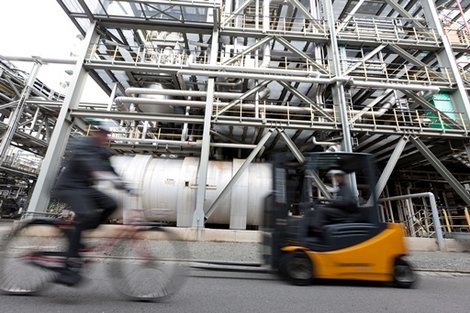HERE invests the chemical industry - with multi-billion Euro investments

Saxony-Anhalt is the home of the chemicals and plastics industry in eastern Germany. This year, the companies that are located here have big plans: the further development of existing structures and facilities and research into new areas of business are expected to provide a further boost to their turnover.
Saxony-Anhalt isn’t just the home of the Reformation – it is also the home of the chemicals industry in eastern Germany. The chemicals industry now accounts for one third of the total economic output in the new federal states of Germany and for almost 20 percent of all industrial production. What has made this success possible? The answer: multi-billion Euro investments, the latest facilities and equipment, highly qualified staff and the concept of the chemical park, which was developed here and which provides for short distances and technological synergies. Between 1991 and 2015, approximately 9.8 billion Euros were invested in property, plant and equipment. No other German federal state has seen so much money flow into its chemicals sector. In 2015, chemicals businesses invested some 270 million Euros in facilities, land and equipment in Saxony-Anhalt.
The central German chemical triangle, the industrial heartland which nestles around the cities of Halle/Saale, Merseburg und Bitterfeld, is home to some of the region’s oldest and best-known companies. Leuna Chemical Park is also to be found here, which is one of the leading locations for the chemicals industry in the world. The German subsidiary of the American (USA) corporation the Dow Chemical Company is situated in Leuna. Over the next two years, the corporation is set to invest some 300 million Euros in the maintenance and upgrading of its existing production facilities.
DOMO Chemicals, a polyamide-6 manufacturer, and TOTAL Refinery Leuna, meanwhile, are together planning to invest some 60 million Euros in a plant for the extraction of benzene. The companies based in Leuna have invested a total of 250 million Euros. The owner and operator of the infrastructure facilities at the chemical park is Infra-Leuna. The company is one of the major investors; in the past three years, 100 million Euros have been spent on improvements to the park’s infrastructure. Projects to the value of 37 million Euros are scheduled for completion in 2017, including the opening of a new shunting yard.
There are also big plans for Zeitz Chemical and Industry Park. At the start of the year, its operator, Infra-Zeitz Servicegesellschaft mbH, officially embarked on the extension of the central water treatment plant, which is to cost around seven million Euros. This development is part of an extension project with a total scheduled cost of 18.1 million Euros, 12 million of which is being provided by the federal state of Saxony-Anhalt. Over the course of this year and next, the company Puralube which is situated at Infra Zeitz, is investing a double-digit multimillion sum in the upgrading of its location. In the near future, the new part of its refinery is to be home to the manufacturing of premium base oils of exceptionally high quality.
The biggest manufacturer of ammoniac in Germany, Stickstoffwerke Piesteritz which is situated in Wittenberg, is also set to expand and is investing some 75 million Euros in increasing its capacity. This is in response to increasing demand for its products which is driving its turnover. Its productive capacity is to increase by 250 tonnes per day. It is also set to reduce its energy consumption by approximately eight percent – a worthwhile investment at a company that has to burn 140,000 cubic metres of natural gas per hour.
A network between the worlds of research and industry, by contrast, wants to embark on a brand-new path: Hydrogen Power Storage and Solutions East Germany, or HYPOS for short. This consortium of 121 members, including major companies and scientific institutes, is working on the production of the storable energy source of hydrogen from sources of renewable energy. The idea behind the development of a new way of using so-called “green” hydrogen in the chemicals industry is particularly attractive in a federal state in which wind turbines and solar plants are ubiquitous and which is also home to German’s biggest network of pipelines, totalling approx. 500 kilometres. In this respect, the use of the hydrogen as both a base chemical and in the field of fuel cells technology is conceivable. Sustainable, environmentally friendly and effective: the plans of HYPOS are so promising that its project has been included in the “Zwanzig20” project of the German federal government. The project has an investment volume of some 70 million Euros, 45 million of which are from subsidies.
According to the statistics of the German Association of the Chemicals Industry e.V., North East Region, in 2015, 18,100 people were working in the chemicals industry. Especially noteworthy is that the productivity of the companies, measured by turnover per employee, is very high. This increased from 390,000 Euros in 2006 to 460,000 Euros in 2015. In 2015, the productivity of the average industrial employee in Saxony-Anhalt was approximately 300,000 Euros.
The year 2017 got off to a good start in the homeland of the chemicals industry. In the first quarter of the year, turnover totalled some 2.1 billion Euros – a clear increase compared with the year before. The production of base chemical materials continues to be the key mainstay of the chemicals industry in Saxony-Anhalt. In 2016, the turnover of the companies operating in this sector amounted to approximately five billion Euros.
The locations for the chemicals industry in Saxony-Anhalt have proven particularly attractive to foreign investors: more than a quarter of all the jobs created as a result of foreign investment in Saxony-Anhalt have been created in the chemicals sector. The region has recently added another plus point: a regional working agreement which is second to none in terms of its flexibility. According to the agreement, from now on, the collective bargaining partners have determined the regular working hours on the basis of an agreement. Accordingly, depending on the volume of work, employees are able to choose working hours of between 32 and 40 hours. Another locational advantage for Saxony-Anhalt has therefore come to fruition.
Author: Anja Falgowski
> more about the Chemical and Plastics Industry Saxony-Anhalt





